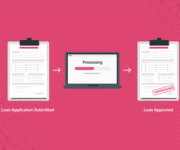A recent report predicts that Indian banks will witness a credit growth of 12.5 per cent growth in the financial year 2025.
Despite this positive outlook, using outdated tools and processes, in particular, puts lenders at risk, especially as they attempt to scale faster.
For instance, they may experience a growth of loan delinquencies and Non-Performing Assets (NPAs). They may struggle with compliance issues and suffer consequences such as bankruptcy, suspension of services, and shutdown.
The use of technology, however, can help lenders address many challenges simultaneously.
For instance, integrating process automation in a loan origination system empowers lenders to bring efficiency and accuracy to underwriting operations. They can reduce errors, build user-friendly processes, and deliver customised loan solutions. Let’s take a closer look.
Loan Origination System: 4 Key Challenges That Contribute to Errors
Here is a snapshot of key factors that lead to errors in the loan origination system outcomes:
1. Manual Processes still in Use
Though legacy systems add some value, lending teams continue to perform many tasks manually. For instance, manual data extraction from bank statements can result in several errors, including omitted, incorrect, and duplicated data.
2. Inaccurate Data Classification & Analysis
Lenders often cannot identify transaction sources and destinations, suspicious financial transactions, and irregular borrower behaviour.
As a result, they fail to comprehensively analyse the data and deliver the best underwriting outcomes.
3. Compliance Errors
The regulatory framework for lenders is evolving so quickly that lenders struggle to keep pace with changes.
Due to the sheer volume of loan applications, the inability to follow regulatory guidelines comprehensively can result in severe consequences for lenders.
4. One-size-fits-all Loan Solutions
Lenders tend to deliver standardised loan products, which can prove unaffordable to many borrowers. This is because they lack the tools to assess the repayment capabilities of borrowers with no credit history.
This scenario comes with an opportunity cost for lenders who miss out on converting such customers.
Process Automation in a Loan Origination System: An Overview
Process automation in a loan origination system refers to the use of technology to automate a range of repetitive tasks in the lending work cycle.
- Human interventions to perform such tasks can result in errors and inconsistencies, especially as the volume of loan applications rises.
- With the demand for credit expected to rise, lenders must equip their teams with automated solutions to bring efficiency to daily lending operations.
For instance, adopting the use of an AI-powered loan origination system is helping lenders automate all tasks. - In turn, lenders can process and analyse data more efficiently, reduce errors, and identify the unique needs of borrowers more effectively.
X Ways an Automated Loan Origination System Reduces Errors
Process automation delivers value to a loan origination system in multiple ways, as follows:
1. Automates Financial Data Collection
Borrowers often deliver incomplete loan applications. Despite follow-ups by lenders, borrowers may delay data submission or omit key data. This is an unsustainable approach, which leads to inaccurate financial analysis of the data.
With the introduction of process automation, a loan origination system can directly pull data from the relevant sources via tools such as bank aggregators. This is a more effective, sustainable approach to data collection.
2. No Manual Data Extraction
An automated loan origination system streamlines data extraction from documents such as bank statements. Data can be extracted from over 1000 document formats. Data is extracted without errors, omissions, or data duplication within seconds.
This process does not require any human intervention and can be concluded swiftly.
3. Efficient Transaction Categorisation
Transaction data is automatically segregated into two main categories – inflow and outflow. The transactions can be further segregated into subcategories.
For instance, employee salaries, taxes, and EMIs are common outflow categories. Common outflow categories include revenues, interest, tax refunds, and capital gains.
Such specific categorisation ensures that the source and destination of every transaction are accounted for.
4. Automated Bank Statement Analysis
AI-powered loan origination systems can analyse financial data within minutes and generate detailed reports.
Furthermore, lenders can customise dashboards to generate specific data insights that meet their needs.
For instance, predictive analytics capabilities can help lenders accurately predict borrowers’ likelihood of making repayments based on past credit behavioural patterns.
5. Identifying Irregular Transaction Patterns
Automated loan origination systems can flag irregular or unusual transaction patterns quickly and effectively.
For instance, lenders can identify transactions, consistent late EMI payment behaviour, and tax evasion/ fraud based on transaction patterns.
Such capabilities enable lenders to weed out cases of potential fraud and NPAs early on.
6. Automate Compliance
Lenders can leverage a combination of automation and machine learning to ensure that all underwriting outcomes comply with regulatory guidelines.
This approach enables lenders to strengthen compliance processes while saving on time and resources invested in this function.
7. Alternative Credit Score
Lenders can generate an alternative creditworthiness score to use as a benchmark to make underwriting decisions. Unlike traditional credit scores, an alternative score considers the latest bank statements, which reflect various aspects of a borrower’s financial profile.
For instance, borrowers are evaluated not only on past credit behaviour but also on spending patterns, cash flows, and income sources.
8. GST Cross-Referencing
Financial data that shows up as business revenues can be cross-referenced using Goods And Service Tax Returns (GSTR) data.
For instance, every incoming revenue transaction can be cross-checked and confirmed using corresponding GSTR data. The data can be directly pulled from the GSRTC portal with the borrower’s consent.
The entire workflow can be completely automated, saving lenders time and resources while offering additional credible data.
9. Personalisation of Loan Products
Borrowers come with diverse financial profiles, which impact their credit needs. For instance, a micro business’s needs vastly differ from those of a medium-sized business or a corporation. Manually personalising loan products, however, is a time-consuming process.
Instead, lenders can automate and deliver data-driven loan solutions using a cloud-based automated loan origination system. By taking this route, they can attract new customers into the ecosystem and focus their efforts on driving conversions of underserved credit seekers.
Final Takeaway
Today, banks, Non-Banking Financial Companies (NBFCs), digital lenders, and fintechs are all vying for a slice of the lending market. Lenders need to build a competitive edge as the demand for unsecured loans grows. Those who invest early in a cloud-based loan origination system can reap the benefits of process automation.
Finezza, the cutting-edge micro loan management software, streamlines lending processes. It automates applications, credit assessments, and approvals, ensuring security and compliance.
The platform also harnesses AI technology to provide tailored analytical solutions, enhancing loan decision-making, reducing lead-to-loan time, and effectively evaluating creditworthiness for faster loan approvals.
Sign up to learn more about Finezza!




Leave a Reply